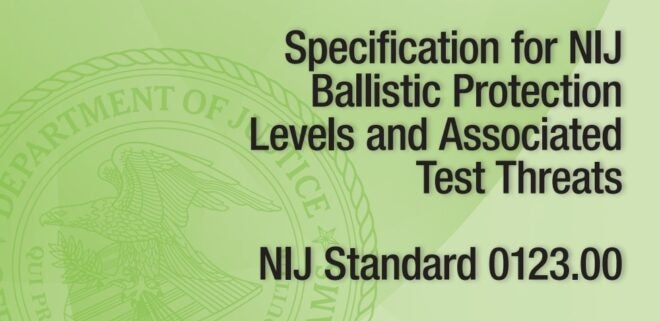The days of the old “levels” of body armor are coming to an end. Finally, the National Institute of Justice released their long-awaited new armor classification guide. Let’s take a look at NIJ 0101.07 and NIJ 0123.00 to see what the new ratings look like.
Body Armor Articles @ TFB:
- New Rifle-Rated Plates for Women from Safariland
- Strike Industries Distributing Hyperion Armor RF2/Level III+ Plates
- TFB Review: Premier Body Armor’s Backpack Armor Insert
- Premier Body Armor Releases Its New Discreet Plate Carrier
History
If you’ve ever looked at body armor you’ve probably seen ratings like Level III and Level IV. In short and without getting too far into the weeds, Level IIA, Level II, and Level IIIA were for handgun rounds. Level III and Level IV were for rifle rounds. “A” ratings indicate a lesser rating, so Level IIA offers less protection than Level II.
That system served well for many years but doesn’t make that much sense. Level IIIA doesn’t really have much in common with Level III. The ammunition types used in Level III and Level IV left a weird gap between those two. Some manufacturers created their own “III+” or “special threat” ratings that split the difference. That is obviously not great for buyers because those ratings are not standardized or tested uniformly.
The trends discussed earlier in the world of armor led the NIJ to reevaluate the rating system. There was talk of the new rating system coming in 2018 or 2019, but it finally arrived in late 2023. As expected, it addresses the IIIA/III confusion as well as the III/IV gap. It also spells out the testing methodology in great detail.
NIJ 0101.07
The NIJ separated the new armor rating system into two separate publications. 0101.07 covers (in exhaustive detail) the testing protocol for various types of armor. Things like backface deformation calculations and how close to the edge of the armor test rounds can hit. These tests also consume quite a few pieces of armor, in some cases as high as 83. NIJ testing is not some guy in a shed shooting one plate a couple of times and calling it good. Just check out this flow chart for the testing process for one type of armor:
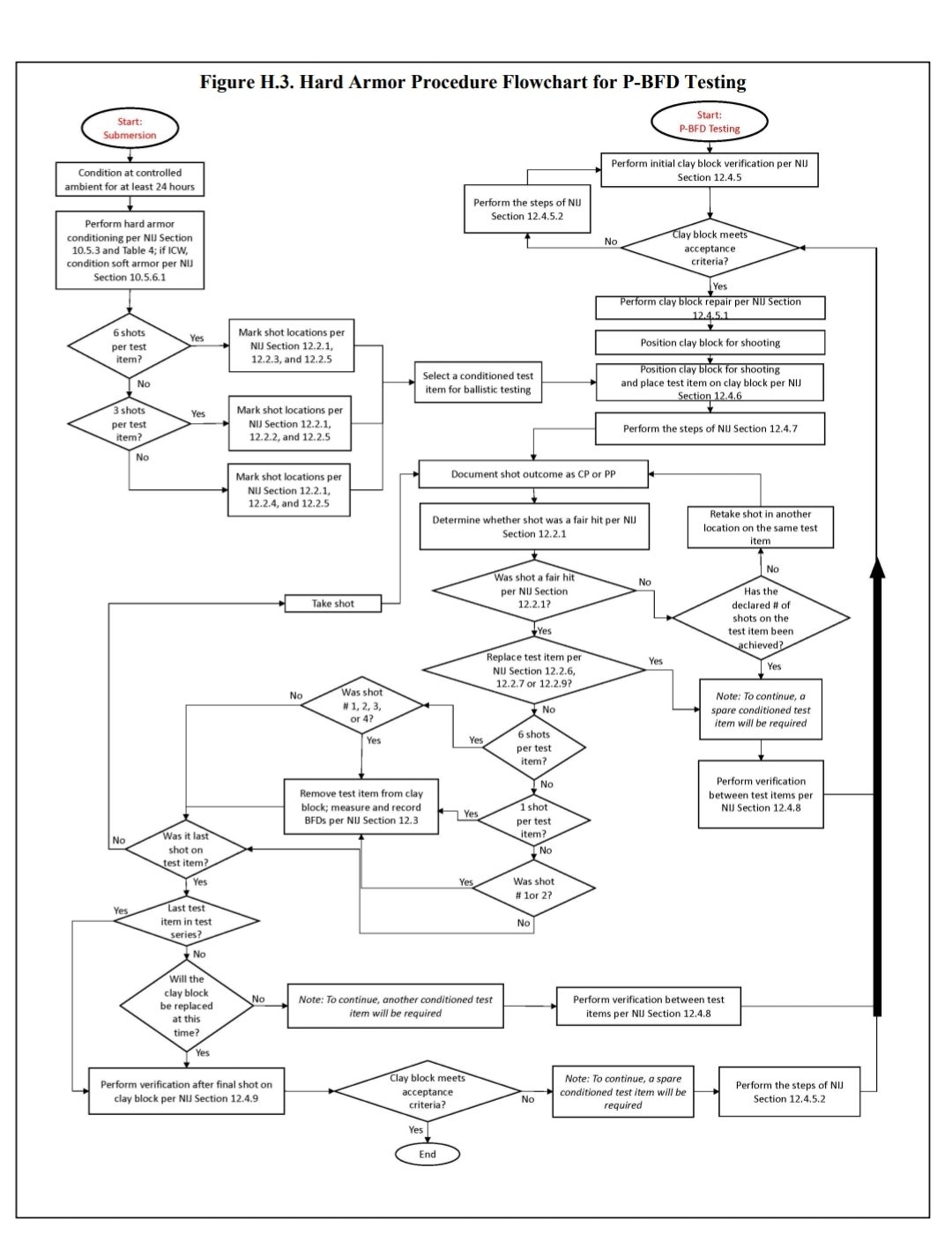
NIJ 0101.07, Figure H.3
One interesting diagram shows the array of hits that a sample hard armor plate must sustain in order to pass. The dark spots are locations where rounds will impact. Each round shows the angle it will impact from. So the six hits on a multi-hit plate break down to three head-on hits spread around two inches from the edge of the plate, one angled hit at 30 degrees on that same line, one hit in the middle top area of the plate, and one in the middle area at an opposing 30-degree angle.
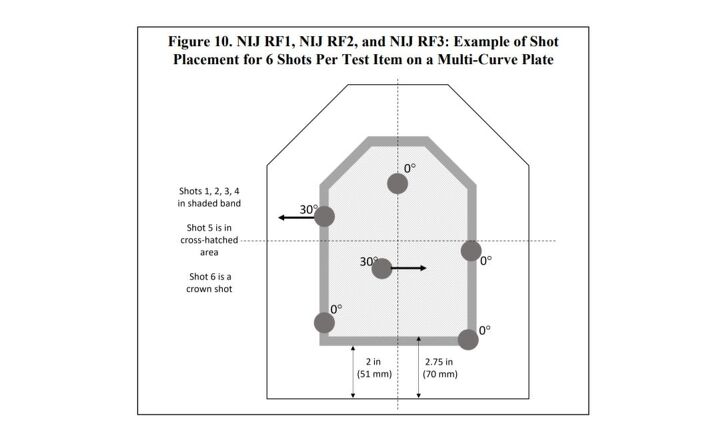
NIJ 0101.07, Figure 10
NIJ 0101.07 is 87 pages long and is full of interesting details about how armor will be tested. If you wear armor or are in a position to buy armor that other people wear this is worth a read to understand what armor is tested to do. It is also really important to know what kinds of things are not tested.
NIJ 0123.00
Most people will care more about 0123.00 as they are shopping for new armor. There are five types of armor rating. HG (for handgun) 1 and 2, and RF (for rifle) 1, 2, and 3. First up we have the handgun levels. The old system was, in order of increasing protection, IIA, II, and IIIA, which makes almost no sense. Moving to only two ratings makes sense because IIA is fairly uncommon these days.
There are only two handgun protection levels under NIJ 0123.00. HG1 handles 9mm and .357 magnum threats. HG2 also covers 9mm and adds .44 magnum. Of note, the test spec for the 9mm load for HG1 is 1,305 feet per second. For HG2 the specified velocity is 1,430 feet per second. That is a sout load with 124-grain 9mm ammo. Both of those loads are running quite a bit faster than the 1,000-1,100 FPS that 124-grain ammo will do from the average handgun, and look more like submachinegun (HG1) and 16″+ PCC (HG2) stats. The magnum revolver loads both clock in at 1,430 feet per second.
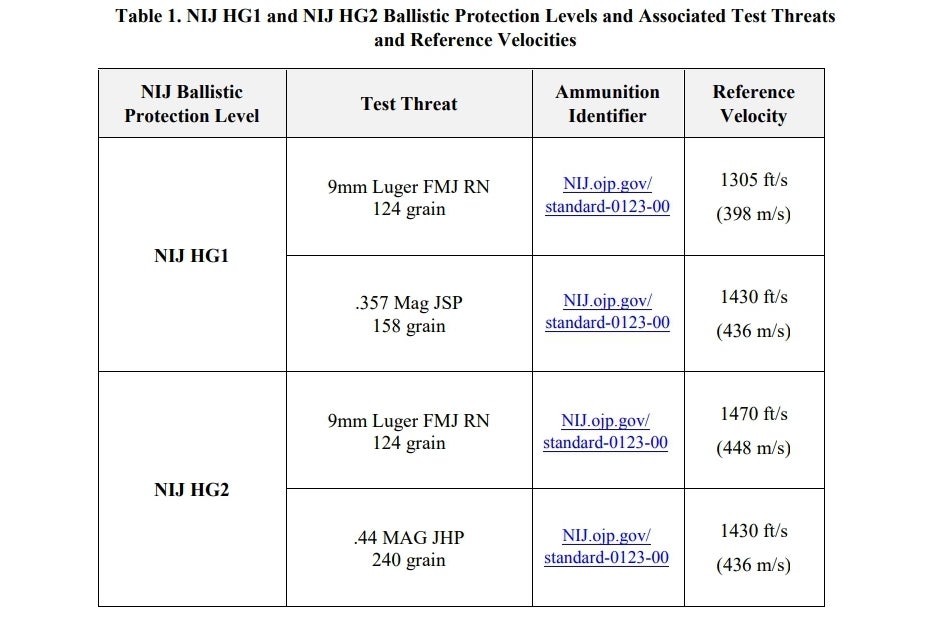
NIJ 1023.00, Table 1
Turning to rifle threats, there are now three options instead of two. RF1 is the lowest level and offers protection against 7.62 NATO, 7.62×39 with a mild steel core, and 5.56 M193. RF2 keeps those threat levels and adds 5.56 M855. The NIJ specifies 3,250 FPS for the M193 and 3,115 FPS for the M855 loads. Those are spicy velocities made possible by a 20-inch barrel, which is the true and correct barrel length. RF2 also fills the space for a “special threat” plate, with protection against the steel core in the M855 but not full-on actual armor-piercing projectiles.
Rounding out the list is RF3, which is only tested with .30-06 M2 armor piercing (aka black tip) ammo. That is a brutal round, and if it can handle the ~80-grain steel core of the M2 AP load at 2,880 FPS then everything else will be easy. This also necessitates changing “Are those plates Level IV” jokes to “Are those plates RF3” jokes.
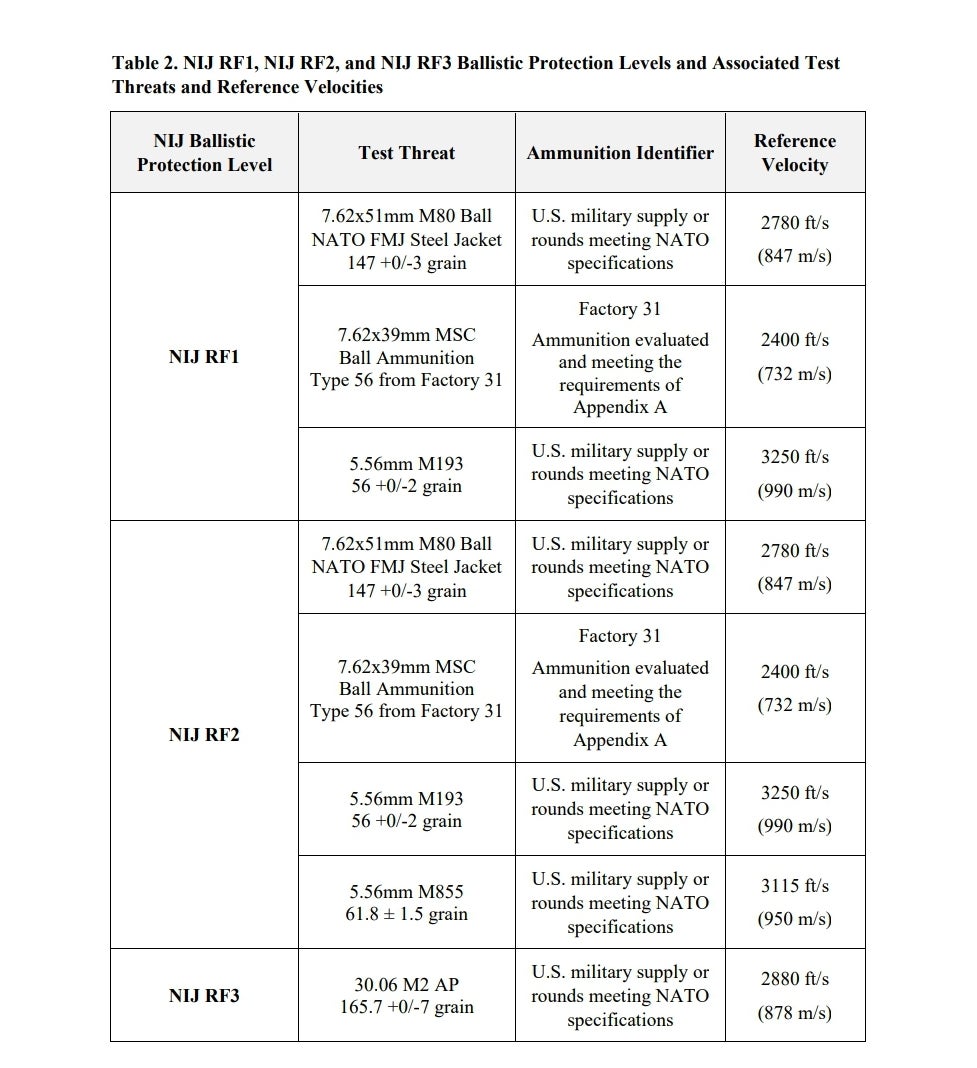
NIJ 0123.00, Table 2
Conclusion
I am not an expert in this field, but it seems like NIJ 0123.00 and 0101.07 are improvements to the old “Level” system. Seeing that a piece of armor is HG2-rated or RF1-rated gives a very clear distinction, unlike the old IIIA/III overlap. This new system clearly builds on the older standards and makes them easier to understand for the average buyer, and that is a win in my book.
 Your Privacy Choices
Your Privacy Choices
